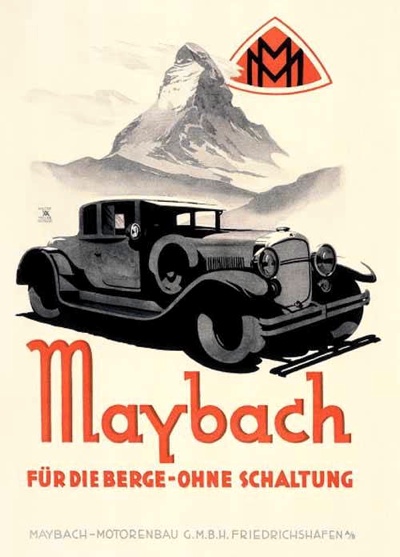Maybach
|
1901 - 1939 |
Country: |
 |
|
Wilhelm Maybach
We would not blame you if you had never heard of
Wilhelm Maybach, a brilliant, unassuming engineer who was one of the founders of motoring. It was
Maybach, in association with Paul Daimler, son of
Gottlieb Daimler, who was mainly responsible for the first Mercedes of 1901, a design that was to revolutionise car design.
This
Maybach design was the first to use mechanically-operated inlet valves which permitted previously unknown engine flexibility and silence, the first to use a gate change for the
gear lever, and the first to use a honeycomb radiator. The new Maybach-designed Mercedes set a pattern for the car of the future.
Graf Zeppelin
Later
Maybach forsook the car for aero engine development, eventually building engines for Zeppelins and, long after the 1914-18 War, V-12 engines for the famous Graf Zeppelin airship. During the thirties these engines inspired a fabulous line of V-12 Zeppelin Maybach cars, capable of over 160km/h and rated by many as the most beautifully-made high performance vehicles of their age. They were, naturally enough, some of the most costly cars in the world.
Maybach's decision to return to cars came immediately after the 1914-18 War, when Germans were prevented from building aeroplanes and airships. His first car of the twenties, the W3, appeared in 1921. It was a beautifully made touring vehicle powered by a 5.8-litre six-cylinder side-valve engine and was capable of almost 120km/h. It was a very advanced car for its day: not only was it the first German vehicle to be fitted with four wheel brakes,' but it had sun and planet gears, similar to the T model Ford, to minimise gear changing.
Electric Starter
Maybach was one of the first to move in the direction of easier driving. Electric starting was operated by the accelerator pedal, which could set both engine and car in motion. Depressing the forward gear pedal would engage a low gear with plenty of power for mountain roads. When released to engage top, the normal gear picked up direct drive suitable for all other motoring: a separate pedal was provided for reverse. The chassis was equally advanced in design and had boxed side members front and rear to provide stiffness and good handling.
In 1926 this model was replaced by the even more luxurious W5, with seven-litre o.h.v. six-cylinder
engine. It was a slightly heavier car and although only about 8 km/h faster, conformed to Maybach ideas that the true essential of modern driving was an ability to go more quickly and easily from point to point rather than go at high all-out speeds. An overdrive to increase the top speed to 140km/h was made available. In 1930 this model was further refined and became the W6.
 Reklama Maybach W3.
Reklama Maybach W3.
|
The V-12 Mayback Zeppelin
Soon after 1930 the first V-12 Mayback Zeppelin appeared. It was said to have been inspired by the high performance of the Porsche type SSK 38/250 Mercedes. This Maybach had a V-12 engine of 6922 cm3 producing 112kW at 2800rpm and running in eight main bearings.
An overhead camshaft, placed between the two banks of cylinders, operated valves by pushrods and rockers. Twin Solex carburettors with double float chambers replaced the former Maybach carburettor of similar type, and hand-controlled ignition permitted the use of a variety of petrol grades.
The three-speed gear box had a vacuum servo-controlled overdrive, operated by a lever in the centre of the
steering column to provide six forward ratios even though the engine was so flexible that it was virtually an all-day top gear car.
Suspension was by semi-elliptic
springs front and rear.
Within a year or two this model was superseded by the even bigger DS8 with 7977cm V-12 engine, which by 1938 was developing 150kW at 3200rpm. These huge, superbly-built Maybachs, which had a top speed of close on 190 km/h, were favored by wealthy international bankers and industrialists, who were true connoisseurs of fine cars.
The servo-assisted gear change offered seven forward ratios, but to buy a Maybach you had to be exceedingly wealthy. The bodies were usually designed by the leading European coachbuilders to individual requirements, cost being the last item to be considered. Alongside the big cars smaller, less expensive models with six-cylinder engines were produced.
First came the DSH 5.2 litre which had a 100kW engine and conventional chassis like the big V12s. The five-speed transmission had a floor
gear lever to select first or reverse, the remaining four speeds being operated by servo-assisted steering column control lever. The 140km/h DSH was built between 1934 and 1937.
Karl Maybach
Smaller still was the SW range and all-independent
suspension - swing axles at the rear and a 3.5-litre engine, increased to 3.8 litres in 1935, when the model became known as the SW 38. It had a top speed of around 160km/h. Karl Maybach, son of Wilhelm, who now controlled the firm, was mainly concerned with building expensive prestige cars and only a small part of the huge Friedrichshafen output was devoted to private cars. In 1939, the SW 38 gave way to the SW 42. This was built for only a few months before the Second World War when production of all private cars ceased.
After the war, the great firm of Maybach decided against re-introducing cars. The factory did do some repair work, but automotive production was never restarted, and some 20 years later, the company was renamed MTU Friedrichshafen. Daimler-Benz purchased the company in 1960. Post 1960 the company was mainly used to make special editions of Mercedes cars in the W108 and W116 model range which were virtually hand built. These cars however carried the Mercedes badge and serial numbers. For the purposes of the Unique Cars and Parts Lost Marques section, we believe the great marque simply ceased to exist around 1939. From 1997 Mercedes would resurrect the name for their high-end limousine range.



